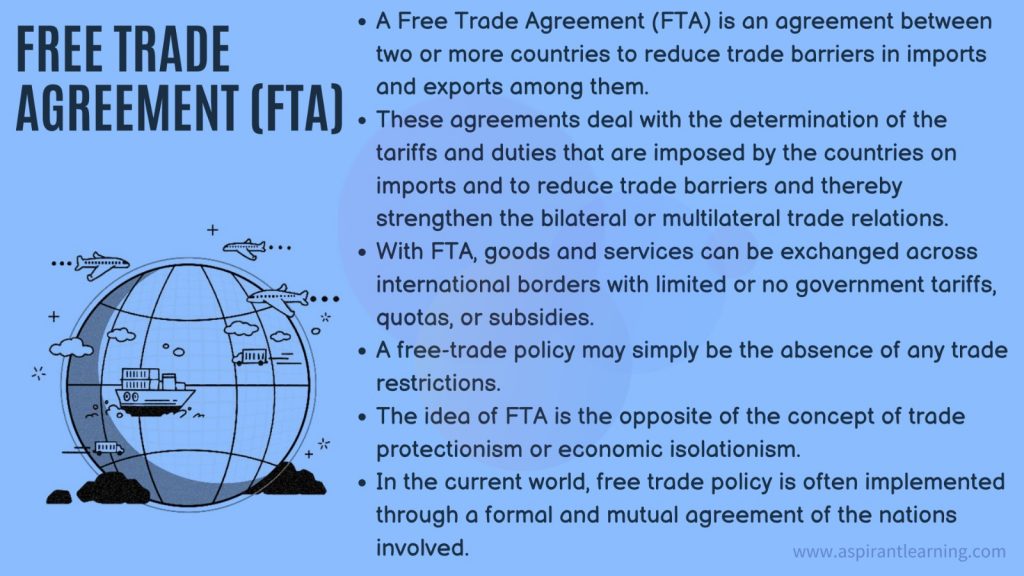News Highlights:
- Recently, The U.K. acceded to the Comprehensive and Progressive Agreement for Trans-Pacific Partnership (CPTPP).
- Westminster and each of the CPTPP countries must now ratify the agreement.
Key takeaway:
On 1 February 2021, the United Kingdom (UK) formally requested accession to the Comprehensive and Progressive Agreement for Trans-Pacific Partnership (CPTPP).
CPTPP:
- Member Countries:
- Comprehensive and Progressive Agreement for Trans-Pacific Partnership (CPTPP)—a free trade agreement between Canada and 10 other countries in the Asia-Pacific: Australia, Brunei, Chile, Japan, Malaysia, Mexico, New Zealand, Peru, Singapore and Vietnam.
- Background:
- The CPTPP was signed by the 11 countries on March 8, 2018, in Santiago, Chile.
- The CPTPP entered into force on December 30, 2018, for: Australia, Canada, Japan, Mexico, New Zealand, and Singapore, and on January 14, 2019, for Vietnam.
- CPTPP Agreement:
- The Agreement calls for a free trade area to be created as per requirements of Article XXIV of the General Agreement on Tariffs and Trade (GATT) and Article V of the General Agreement on Trade in Services (GATS).
- The agreement mandates the duty-free entry of commercial samples having almost negligible value and printed advertising material from the territory of a signatory party.
- CPTPP covers virtually all sectors and aspects of trade in order to eliminate or reduce barriers. It establishes clear rules that help create a consistent, transparent and fair environment to do business in CPTPP markets.
- It eliminates tariffs and reduces barriers for 98% of exports to CPTPP member countries.
- It also includes trade-related technical cooperation among CPTPP members, including with respect to small and medium-sized enterprises, regulatory coherence and economic development
- Objectives of CPTPP:
- CPTPP covers virtually all sectors and aspects of trade in order to eliminate or reduce barriers
- It establishes clear rules that help create a consistent, transparent and fair environment to do business in CPTPP markets
- It also includes chapters on the protection of the environment and labour to ensure that CPTPP members do not derogate from their commitments in these areas to increase trade or investment
- Straightforward rules of origin and origin procedures are set under the Comprehensive and Progressive Agreement for Trans-Pacific Partnership
- The custom procedures have been made simple, effective, clear and predictable.

Significance of CPTPP:
- Competitive advantage over exporters:
- In every province and territory, the Comprehensive and Progressive Agreement for Trans-Pacific Partnership (CPTPP) will offer exporters a competitive advantage over exporters from other countries that do not have a free trade agreement with countries in the Asia-Pacific region.
- Eliminate tariffs:
- Once fully implemented, CPTPP will eliminate tariffs on almost all Canadian exports to CPTPP markets and create better export conditions.
- Other Benefits:
- Reduced barriers to trade.
- Increased access to government procurement.
- Consistent, transparent and predictable trade environment.
- CPTPP helps reduce unnecessary regulatory requirements.
CPTPP Commission:
- Overview:
- The Comprehensive and Progressive Agreement for Trans-Pacific Partnership (CPTPP) Commission reviews the implementation of the agreement and considers ways to advance trade and investment between CPTPP members further.
- The Commission consists of ministers and senior officials from CPTPP members.
Pic Courtesy: Freepik
Content Source: The Hindu



